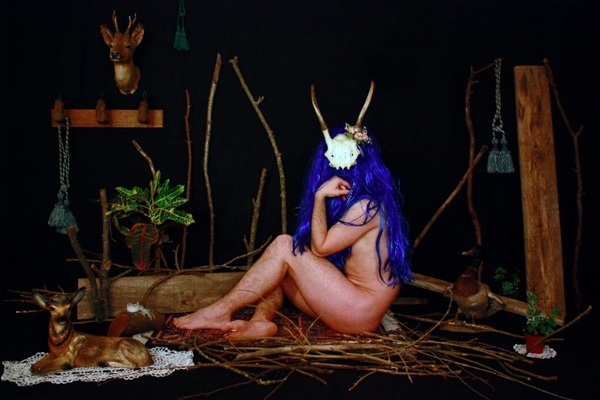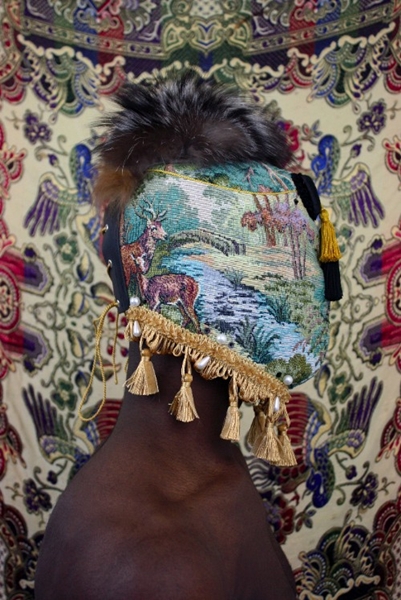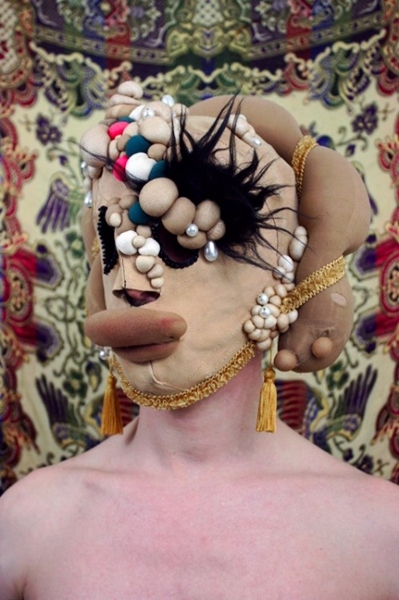"Birds of a feather fly together"
Mehryl Levisse
Catinca Tabacaru Gallery
 250 Broome Street New York, NY 10002 United States
250 Broome Street New York, NY 10002 United States +1 212-260-2481 e-mail:
June 7 > July 9, 2017
 Mehryl Levisse, Le lieu reposé du chevreuil, archival c-print, 100 x 60 cm, 2013 |
 renatus barbatus, 2015, hand-sewn mask sculptures by Mehryl Levisse |
 sixtus pavonina, 2015, hand-sewn mask sculptures by Mehryl Levisse |
In
his first New York solo exhibition
Birds of a feather
fly together,
opening
June
7th at Catinca
Tabacaru
Gallery,
250 Broome
Street,
New York, NY 10002,
young
French
artist Mehryl
Levisse
presents
an eccentric
world blending
childhood
memories,
like the
drama
he learned
from his Italian aunts who
were mourners
and paid to cry at funerals,
with art history,
BDSM
references,
and the
aesthetics
of Champagne-Ardennes,
the ru
-
ral backwoods
where he spent his formative
years. This history-laden
region of France
has
become
neglected
as its population
dwin
-
dles.
“There, decrepit mansions are full of dusty decorations, yellowish wallpapers and charged ornaments. I love these caulk atmospheres: they are eerie and reassuring at the same time...” says Levisse, whose work was exhibited at Centre Pompidou and Musée de la Chasse in Paris in the past year.
In New York, Levisse has turned the gallery into an immersive environment with every sur - face covered in his kaleidoscopic wallpaper. Four photographs, six masks and two performers grace the space, inviting us into their shadowy realm.
Using bodies, his and those of others, Levisse’s aesthetic is infused with nudity and comic situations. Wild and elaborate costumes are meticulously crafted and sewn by his own hand, while privy limbs writhe in colorful Aubusson-esque tapestries. Fantastical characters play hide- and-seek and strike frisky poses while the photographs are blessed with double meanings and a satisfying absurdity. This balance seems fragile, poetic and provocative.
The meticulous sets he creates and installs are parodies of society, both critical and pa - thetic, manipulating the long-established codes of theater, and implementing the body as an object. He thinks of his photographs as documents, traces of moments and situations that took place in his studio. For this reason, he does not edit or manipulate the images created.
In one image, his lover poses like an Odalisque, a colony of mollusks affixed on his face and flanks. In another frame, Levisse’s bare buttox arises from a sea of dark colored tapestries. The title of the latter, “faire tapisserie” ( i.e. to melt into the decor), referring to a phrase to de - scribe people who are not noticed or who are not important - the invisibles.
Six sculptures occupy the center of the gallery’s space. Each is a mask made with preci - sion using such noble materials as fine Calais lace, pearls, leather, ornate tapestry off-cuts, and human hair. They are impaled on iron rods erected on a carnival-like stage of glowing colored lights. They give birth to mysterious visages, erotically loaded and sewn to fit the artist’s own face. Levisse leaves us to wonder if upon wearing one we might be consumed by it, relinquishing our individual selves to the spirit within.
About the Artist:
Mehryl Levisse was born in Charleville-Mézières, France and lives and works between Paris, Casablanca, and Raillicourt (Champagne-Ardenne). Working in photography, in - stallation, and performance, his multimedia practice explores cultural boundaries, social issues and the archetypal representation of the body. His background in dance (jazz, ballet, and con - temporary), along with an MFA in Contemporary Art and New Media from Université Paris 8, has allowed for Levisse’ work to become transversal, collaborating with philosophers, linguists, and scholars, as well as choreographers, dancers, and puppeteers. In 2011 he founded BALAK: an annual pop-up contemporary art space whose goal is to remedy the lack of a contemporary art program in Charleville-Mézières. .
“There, decrepit mansions are full of dusty decorations, yellowish wallpapers and charged ornaments. I love these caulk atmospheres: they are eerie and reassuring at the same time...” says Levisse, whose work was exhibited at Centre Pompidou and Musée de la Chasse in Paris in the past year.
In New York, Levisse has turned the gallery into an immersive environment with every sur - face covered in his kaleidoscopic wallpaper. Four photographs, six masks and two performers grace the space, inviting us into their shadowy realm.
Using bodies, his and those of others, Levisse’s aesthetic is infused with nudity and comic situations. Wild and elaborate costumes are meticulously crafted and sewn by his own hand, while privy limbs writhe in colorful Aubusson-esque tapestries. Fantastical characters play hide- and-seek and strike frisky poses while the photographs are blessed with double meanings and a satisfying absurdity. This balance seems fragile, poetic and provocative.
The meticulous sets he creates and installs are parodies of society, both critical and pa - thetic, manipulating the long-established codes of theater, and implementing the body as an object. He thinks of his photographs as documents, traces of moments and situations that took place in his studio. For this reason, he does not edit or manipulate the images created.
In one image, his lover poses like an Odalisque, a colony of mollusks affixed on his face and flanks. In another frame, Levisse’s bare buttox arises from a sea of dark colored tapestries. The title of the latter, “faire tapisserie” ( i.e. to melt into the decor), referring to a phrase to de - scribe people who are not noticed or who are not important - the invisibles.
Six sculptures occupy the center of the gallery’s space. Each is a mask made with preci - sion using such noble materials as fine Calais lace, pearls, leather, ornate tapestry off-cuts, and human hair. They are impaled on iron rods erected on a carnival-like stage of glowing colored lights. They give birth to mysterious visages, erotically loaded and sewn to fit the artist’s own face. Levisse leaves us to wonder if upon wearing one we might be consumed by it, relinquishing our individual selves to the spirit within.
About the Artist:
Mehryl Levisse was born in Charleville-Mézières, France and lives and works between Paris, Casablanca, and Raillicourt (Champagne-Ardenne). Working in photography, in - stallation, and performance, his multimedia practice explores cultural boundaries, social issues and the archetypal representation of the body. His background in dance (jazz, ballet, and con - temporary), along with an MFA in Contemporary Art and New Media from Université Paris 8, has allowed for Levisse’ work to become transversal, collaborating with philosophers, linguists, and scholars, as well as choreographers, dancers, and puppeteers. In 2011 he founded BALAK: an annual pop-up contemporary art space whose goal is to remedy the lack of a contemporary art program in Charleville-Mézières. .
QR of press release




Opening reception:
June 7, 6-8PM







